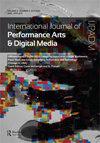Theater in Quarantine
IF 0.9
0 THEATER
International Journal of Performance Arts and Digital Media
Pub Date : 2021-05-04
DOI:10.1080/14794713.2021.1927526
引用次数: 1
Abstract
as a missed opportunity to address a radical and complex question about the manner in which the emergence of new subjectivities shaped by technologies could enable us to decolonise performer training how performer training could not only be heterogeneous and inclusive of different matter, but also be heterogeneous in its inclusion of diverse human and nonhuman perspectives. Performer Training and Technology. Preparing Our Selves is likely to appeal to theatre and performancepostgraduate students, scholars andpractitioners, such as directors, performers, lighting and sound designers, and technicians, with research interests in the philosophy and history of performance training. It could also benefit visual art students, artists, and scholars who are interested in transdisciplinarypraxis intersecting technology, performance, art and training, particularly the sections pertaining to a ‘polyfocal vision’ that promulgates an ability to ‘spot the artefact when it is present as well as appreciate the artefact’s impact when it is absent’ (184). The strongest aspects of the book are Kapsali’s detailed and in-depth analysis, where she explores the manner in which different philosophical approaches to technology have affected and co-shaped discussions about performer praxis in the context of specific case studies ranging from historical practitioners, such as Diderot, Craig, Stanislavsky, Meyerhold, Chaikin and the American avant-garde from 1960s, Lecoq and Zarrilli, to more recent examples, such as Zanotti, Kozel, Keinanen, Rouhiainen, and The Mocap Summit. The most valuable point driving the overall argument is a contention that ‘performer training is technological in and of itself’ (6), which introduces a significant shift in thinking about past and present praxis, underscoring the importance of new ways of approaching preparation for performance. The idea of preparation is discussed as a central aspect of training a process through which the expectations of training are articulated, and ‘as a sense of individual and collective responsibility towards developing appropriate forms of response to a series of interlinked and mounting crises’ (1). The instrument is another significant term addressed with profound rigour; the text unfolds a detailed account of technological instruments in training (such as: handheld objects, electric light circuits and digital devices like mobile phones, motion capture), while simultaneously exploring training as a process of instrumentalization, explicating that an understanding of technology and the performer-as-instrument are inexorably akin. In summation, Kapsali’s new perspective on contemporary performer training is not only timely, but also initiates an important and much-needed debate within the field of performing arts to reconsider, negotiate and reformulate ‘doing-thinking’ that intersects technology and performer training. Hopefully, it will inspire the designers of curriculums, trainers, and trainees, who wish ‘to develop new ways of being in the world’ (7).隔离中的剧院
由于错过了解决一个激进而复杂的问题的机会,即技术塑造的新主体性的出现使我们能够使表演者培训去殖民化,表演者培训如何不仅是异质的,包括不同的问题,而且在包括不同的人类和非人类观点方面也是异质的。表演者培训和技术。《准备我们的自我》可能会吸引戏剧和表演研究生、学者和从业人员,如导演、表演者、灯光和音响设计师以及技术人员,他们对表演训练的哲学和历史有研究兴趣。它也可以使对交叉技术、表演、艺术和培训的跨学科实践感兴趣的视觉艺术学生、艺术家和学者受益,特别是与“多焦点视觉”相关的部分,该部分传授了一种能力,即“在人工制品存在时发现它,以及在人工制品不存在时欣赏它的影响”(184)。书中最有力的方面是卡普萨利详细而深入的分析,她在具体案例研究的背景下,探讨了不同的技术哲学方法如何影响和共同塑造了关于表演者实践的讨论,从历史实践者,如狄德罗、克雷格、斯坦尼斯拉夫斯基、梅耶霍尔德、柴金和20世纪60年代的美国先锋派,勒科克和扎里利,到最近的例子,如扎诺蒂、科泽尔、凯南、鲁希亚宁,以及动作捕捉峰会。推动整个论点的最有价值的一点是“表演者培训本身就是技术”的论点(6),它引入了对过去和现在实践的思考的重大转变,强调了接近表演准备的新方法的重要性。准备的概念是作为培训的一个核心方面来讨论的,通过这个过程,培训的期望被明确表达出来,并且“作为一种个人和集体的责任感,对一系列相互联系和不断增加的危机制定适当的反应形式”(1)。工具是另一个意义重大的术语,具有深刻的严肃性;本文详细介绍了培训中的技术工具(例如:手持设备、电灯电路和移动电话等数字设备、动作捕捉),同时探索了培训作为工具化的过程,说明了对技术和表演者作为工具的理解是不可避免的相似之处。综上所述,卡普萨利对当代表演者培训的新视角不仅是及时的,而且在表演艺术领域引发了一场重要的、急需的辩论,以重新考虑、协商和重新制定技术与表演者培训交叉的“做-思考”。希望它能激励那些希望“开发新的生存方式”的课程设计者、培训师和学员(7)。
本文章由计算机程序翻译,如有差异,请以英文原文为准。
求助全文
约1分钟内获得全文
求助全文
来源期刊

International Journal of Performance Arts and Digital Media
Arts and Humanities-Visual Arts and Performing Arts
CiteScore
1.70
自引率
0.00%
发文量
29
 求助内容:
求助内容: 应助结果提醒方式:
应助结果提醒方式:


